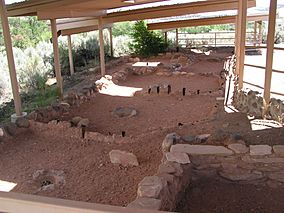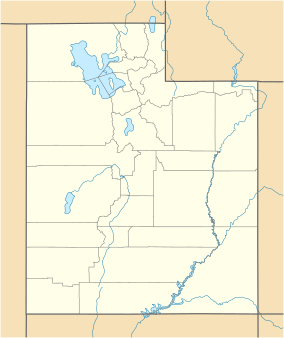Anasazi State Park Museum facts for kids
Quick facts for kids Anasazi State Park Museum |
|
|---|---|

Ancient Anasazi ruins at Anasazi State Park Museum, November 2009
|
|
| Location | Garfield, Utah, United States |
| Area | 6 acres (2.4 ha) |
| Elevation | 6,700 ft (2,000 m) |
| Established | 1960 |
| Named for | the Anasazi people |
| Visitors | 20711 (in 2011) |
| Governing body | Utah State Parks |
| Website | Official website: https://stateparks.utah.gov/parks/anasazi/ |
The Anasazi State Park Museum is a special place in southern Utah, United States. It's a state park and a museum. Here you can explore the remains of an old village. This village was once home to the ancient Anasazi people. It is also known as the Coombs Village Site.
Contents
Exploring the Park and Museum
The Anasazi State Park Museum opened in 1960. It covers about 6-acre (2.4 ha) of land. You can visit it any time of year.
What You'll Find at the Park
The park has a visitor center where you can learn more. There's also a museum filled with amazing items. You can see old pottery and other artifacts made by the Anasazi. There's a museum store and an auditorium too. You can also enjoy picnic areas. However, you cannot camp here.
The park is located in Boulder, Utah. It sits near the huge 11,000-foot-tall (3,400 m) Boulder Mountain.
Discovering the Coombs Village Site
Right behind the museum, you'll find the reconstructed ruins of the ancient Anasazi village. This is the Coombs Village Site. You can walk a special trail through the village. Signs along the way explain what you are seeing. They also teach you about the culture of the people who lived there long ago.
The Ancient Coombs Village
The Coombs Site was one of the biggest Anasazi communities. It was located west of the Colorado River. The word Anasazi comes from the Navajo language. It means "Ancient Enemies" or "Enemies of Our Ancestors." This name is sometimes used for the Pueblo culture. This culture lived in the Four Corners area from about 1 AD to 1300 AD. However, many modern Pueblo people prefer not to use this word. This is because of its negative meaning.
Life in the Village
Experts believe people lived in this village from 1160 AD to 1235 AD. Up to 250 people might have called it home. Most of the village is still underground. But some parts were dug up in 1958 and 1959. This work was done by the University of Utah.
During these digs, archeologists found thousands of old items. They also discovered a community with about 90 rooms. These rooms were in two separate, one-story apartment buildings. One L-shaped building has been rebuilt. Visitors can go inside it. The village also had open shelters for working in the shade. There were storage pits and adobe pit houses. These houses were big enough for five or six people. In total, about 100 structures have been found.
Why the Village Was Left Behind
Evidence suggests the village was abandoned after a big fire. The wooden supports in the buildings were burned. There was also a serious drought in the area at that time. This lack of water might have also made people leave.
See also



